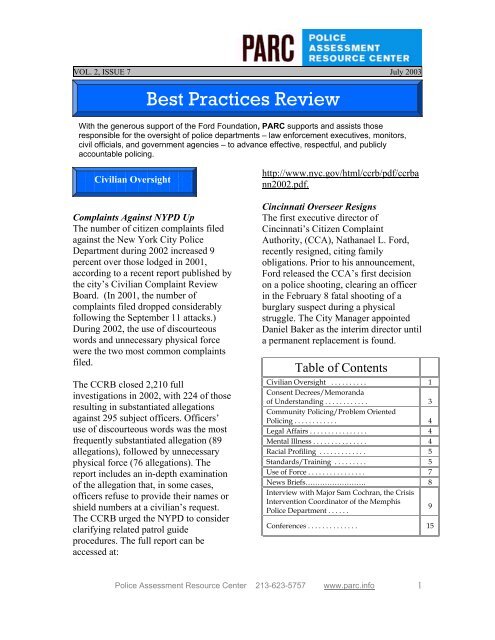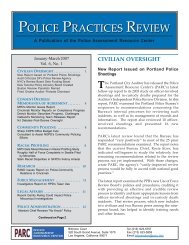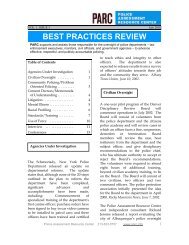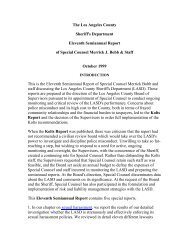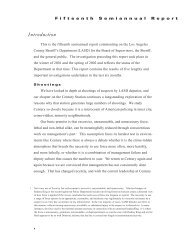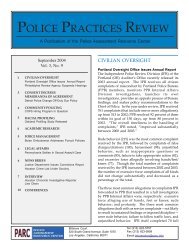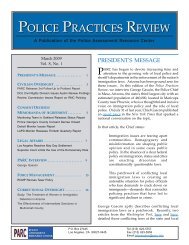July - Police Assessment Resource Center
July - Police Assessment Resource Center
July - Police Assessment Resource Center
Create successful ePaper yourself
Turn your PDF publications into a flip-book with our unique Google optimized e-Paper software.
VOL. 2, ISSUE 7 <strong>July</strong> 2003<br />
accessed online at:<br />
Best Practices Review<br />
With the generous support of the Ford Foundation, PARC supports and assists those<br />
responsible for the oversight of police departments – law enforcement executives, monitors,<br />
civil officials, and government agencies – to advance effective, respectful, and publicly<br />
accountable policing.<br />
Civilian Oversight<br />
Complaints Against NYPD Up<br />
The number of citizen complaints filed<br />
against the New York City <strong>Police</strong><br />
Department during 2002 increased 9<br />
percent over those lodged in 2001,<br />
according to a recent report published by<br />
the city’s Civilian Complaint Review<br />
Board. (In 2001, the number of<br />
complaints filed dropped considerably<br />
following the September 11 attacks.)<br />
During 2002, the use of discourteous<br />
words and unnecessary physical force<br />
were the two most common complaints<br />
filed.<br />
The CCRB closed 2,210 full<br />
investigations in 2002, with 224 of those<br />
resulting in substantiated allegations<br />
against 295 subject officers. Officers’<br />
use of discourteous words was the most<br />
frequently substantiated allegation (89<br />
allegations), followed by unnecessary<br />
physical force (76 allegations). The<br />
report includes an in-depth examination<br />
of the allegation that, in some cases,<br />
officers refuse to provide their names or<br />
shield numbers at a civilian’s request.<br />
The CCRB urged the NYPD to consider<br />
clarifying related patrol guide<br />
procedures. The full report can be<br />
accessed at:<br />
http://www.nyc.gov/html/ccrb/pdf/ccrba<br />
nn2002.pdf.<br />
Cincinnati Overseer Resigns<br />
The first executive director of<br />
Cincinnati’s Citizen Complaint<br />
Authority, (CCA), Nathanael L. Ford,<br />
recently resigned, citing family<br />
obligations. Prior to his announcement,<br />
Ford released the CCA’s first decision<br />
on a police shooting, clearing an officer<br />
in the February 8 fatal shooting of a<br />
burglary suspect during a physical<br />
struggle. The City Manager appointed<br />
Daniel Baker as the interim director until<br />
a permanent replacement is found.<br />
Table of Contents<br />
Civilian Oversight . . . . . . . . . . 1<br />
Consent Decrees/Memoranda<br />
of Understanding . . . . . . . . . . . . 3<br />
Community Policing/Problem Oriented<br />
Policing . . . . . . . . . . . . 4<br />
Legal Affairs . . . . . . . . . . . . . . . . 4<br />
Mental Illness . . . . . . . . . . . . . . . 4<br />
Racial Profiling . . . . . . . . . . . . . 5<br />
Standards/Training . . . . . . . . . 5<br />
Use of Force . . . . . . . . . . . . . . . . 7<br />
News Briefs……………………. 8<br />
Interview with Major Sam Cochran, the Crisis<br />
Intervention Coordinator of the Memphis<br />
<strong>Police</strong> Department . . . . . .<br />
9<br />
Conferences . . . . . . . . . . . . . . 15<br />
<strong>Police</strong> <strong>Assessment</strong> <strong>Resource</strong> <strong>Center</strong> 213-623-5757 www.parc.info 1
VOL. 2, Issue 7 <strong>July</strong> 2003<br />
Baker, who served in the Dayton (OH)<br />
<strong>Police</strong> Department for 25 years, worked<br />
as a consultant to help establish the<br />
CCA. The City expects to have a new<br />
Executive Director by the end of the<br />
year. Cincinnati Enquirer, June 19,<br />
2003.<br />
Austin Monitor Issues First Annual<br />
Report<br />
Austin’s Office of the <strong>Police</strong> Monitor<br />
(OPM), responsible for the oversight of<br />
the Austin (TX) <strong>Police</strong> Department, has<br />
released its inaugural annual report. In<br />
the report’s introduction, the <strong>Police</strong><br />
Monitor, Iris Jones, describes the<br />
accomplishments and challenges the<br />
OPM faced during its first year of<br />
operation.<br />
During the year, the OPM made dozens<br />
of recommendations and requests for<br />
information to the police department.<br />
Among the suggestions made and<br />
accepted by the department were to:<br />
improve training to combat racial<br />
profiling; have officers carry Braille<br />
identification cards for the visually<br />
impaired; and have the department<br />
create a telephone number reserved for<br />
reporting officer misconduct.<br />
The OPM reported that the police<br />
department failed to provide it with<br />
requested information regarding the<br />
number of officers who had received<br />
training on the subject of racial profiling,<br />
the work schedules for officers involved<br />
in shooting incidents for the 30 days<br />
prior to those incidents, and a copy of all<br />
standard operating procedures of the<br />
police department. The OPM also noted<br />
that its staff was unable to attend<br />
interviews with witnesses to alleged<br />
police misconduct because the police<br />
department failed to provide the OPM<br />
with sufficient notification of the times<br />
and locations of those interviews. The<br />
full report can be accessed at:<br />
http://www.ci.austin.tx.us/opm/report.ht<br />
m.<br />
Editors Note: As the BPR was going to<br />
press, we learned that Iris Jones,<br />
Austin's monitor, was resigning. More<br />
details to come in the August edition.<br />
Birotte Is New L.A. Inspector<br />
Andre’ Birotte, Jr. was<br />
recently named the new<br />
Inspector General in the<br />
Office of the Inspector<br />
General (OIG), the agency<br />
that oversees the Los Angeles <strong>Police</strong><br />
Department’s internal disciplinary<br />
process. Birotte, who had served as<br />
Assistant Inspector General before his<br />
promotion, is the third inspector to hold<br />
the post since the office became<br />
operational in 1996. He announced that,<br />
under his leadership, the OIG would<br />
provide more comprehensive and<br />
thorough analysis of complaints,<br />
enhance community outreach, and<br />
improve policy development efforts.<br />
Birotte formerly investigated and<br />
prosecuted violent crime, fraud, and<br />
narcotics trafficking cases for the U.S.<br />
Attorney’s Office in Los Angeles.<br />
Sacramento Observer, May 28, 2003,<br />
and Office of Inspector General Website.<br />
Northern Ireland <strong>Police</strong> Reform<br />
In their latest report on the Northern<br />
Ireland <strong>Police</strong> Service, the Office of the<br />
Oversight Commissioner (OOC),<br />
describes the pace of progress in making<br />
reforms as “excellent” and<br />
“encouraging.” The OOC is a team of<br />
senior law enforcement experts and<br />
academics assigned to oversee the<br />
implementation of a series of<br />
recommendations and reforms<br />
<strong>Police</strong> <strong>Assessment</strong> <strong>Resource</strong> <strong>Center</strong> 213-623-5757 www.parc.info 2
VOL. 2, Issue 7 <strong>July</strong> 2003<br />
established by the Independent<br />
Commission on Policing for Northern<br />
Ireland’s <strong>Police</strong> Service. The report<br />
commends the <strong>Police</strong> Service for<br />
developing a comprehensive human<br />
rights plan; employing a thorough<br />
human resources planning strategy;<br />
installing policies and procedures to<br />
manage and record the use of plastic<br />
baton rounds; and designing and<br />
employing an improved recruitment<br />
program. Despite these<br />
accomplishments, the OOC criticized<br />
progress and made recommendations in<br />
several areas, including the need to:<br />
incorporate a human rights component<br />
into all training sessions; expand<br />
problem-solving training for officers and<br />
supervisors; and conduct additional<br />
research into alternatives to the plastic<br />
baton round. The full report can be<br />
accessed online at:<br />
www.oversightcommissioner.org/reports<br />
/pdfs/may2003.pdf.<br />
Consent Decrees/Memorandum<br />
of Understanding<br />
Detroit <strong>Police</strong> Sign Two Decrees<br />
On June 12, the Detroit (MI) <strong>Police</strong><br />
Department signed two consent decrees<br />
with the U.S. Department of Justice<br />
(DOJ) that mandate reforms to the<br />
department’s policies on use of force,<br />
arrest and detention of witnesses,<br />
training, and officer discipline for the<br />
next five years. Sheryl L. Robinson, of<br />
the security consulting firm Kroll<br />
Associates, was named as the<br />
independent monitor of federal<br />
oversight.<br />
175 problems in the police department’s<br />
policies and practices. Justice<br />
Department officials reportedly told<br />
Detroit’s police chief that they had never<br />
seen problems “as embedded and<br />
entrenched” as found in Detroit’s police<br />
force. The consent decrees require the<br />
department to:<br />
▪ revise the use-of-force policy and<br />
training with an emphasis on deescalation<br />
techniques;<br />
▪ require written supervisory review of<br />
arrests for probable cause, as well as<br />
prohibit the detention of an individual<br />
without reasonable suspicion, probable<br />
cause, or consent from the individual;<br />
▪ analyze trends in uses of force,<br />
searches, seizures, and other law<br />
enforcement activities;<br />
▪ improve procedures for investigating<br />
allegations of misconduct;<br />
▪ develop a comprehensive medical and<br />
mental health screening program; and,<br />
▪ facilitate the public’s access to citizen<br />
complaint forms and to information<br />
about the outcome of complaint<br />
investigations.<br />
Department of Justice Press Release,<br />
June 12, 2003, Detroit Free Press, June<br />
12, 2003, and Detroit News, June 13,<br />
2003.<br />
The decrees follow a 30-month DOJ<br />
investigation that identified more than<br />
<strong>Police</strong> <strong>Assessment</strong> <strong>Resource</strong> <strong>Center</strong> 213-623-5757 www.parc.info 3
VOL. 2, Issue 7 <strong>July</strong> 2003<br />
Community Policing/Problem<br />
Oriented Policing<br />
Informal Contacts Improve Public<br />
Opinion of <strong>Police</strong><br />
In a report entitled, “Factors that<br />
Influence Public Opinion of the <strong>Police</strong>,”<br />
researchers funded by the National<br />
Institute of Justice concluded that police<br />
can improve the public’s opinion of<br />
them if they increase the number of<br />
informal contacts they have with<br />
residents.<br />
The researchers, who surveyed residents<br />
in four geographic areas patrolled by the<br />
Los Angeles <strong>Police</strong> Department,<br />
categorized informal contacts as<br />
visibility in neighborhoods, participating<br />
in community meetings, and talking with<br />
citizens. They found that such contacts<br />
had a positive impact on job approval<br />
ratings and lessened the negative impact<br />
that formal interactions with police –<br />
such as arrests or questioning – may<br />
have had.<br />
The researchers also found that<br />
residents’ level of satisfaction with the<br />
police was more related to their<br />
perception of police efforts to address<br />
violent crime and other community<br />
problems than with critical media<br />
coverage of the police or other factors.<br />
The full report can be accessed online at:<br />
http://www.ncjrs.org/pdffiles1/nij/19792<br />
5.pdf.<br />
Legal Affairs<br />
$170,000 for Improper Sweep<br />
The city of Los Angeles agreed to pay<br />
nearly $170,000 to settle a lawsuit filed<br />
by dozens of homeless people who claim<br />
they were improperly arrested. About<br />
$75,000 will go to as many as 58 people<br />
arrested in a November 2002 sweep<br />
through downtown’s skid row.<br />
The settlement was approved by a 10-4<br />
vote from the City Council.<br />
The agreement stems from a<br />
questionable sweep entitled "Operation<br />
Enough," that was conducted by the Los<br />
Angeles <strong>Police</strong> Department and the<br />
California Department of Corrections.<br />
More than 200 people reportedly were<br />
arrested, 84 of them for supposed parole<br />
violations. The suit asserts that police<br />
had warrants for only 26 of the parolees<br />
and no legitimate reasons existed for the<br />
detention of the others. Los Angeles<br />
Daily News, <strong>July</strong> 10, 2003 and the Los<br />
Angeles Times, June 12, 2003.<br />
Mental Illness<br />
Arizona Enhances Training<br />
The Arizona Peace Officer Standards<br />
and Training Board agreed to develop<br />
training for new state police recruits to<br />
assist them in dealing better with<br />
mentally disabled individuals. The<br />
training is expected to begin next year<br />
and will teach officers how to identify<br />
symptoms of mental disability,<br />
communicate more effectively with<br />
mentally disabled residents, and avoid<br />
deadly confrontations with them.<br />
Arizona Republic, May 27, 2003.<br />
SFPD: $500,000 Settlement<br />
The San Francisco <strong>Police</strong> Commission<br />
recently agreed to a $500,000 settlement<br />
with the family of a mentally ill man<br />
who was fatally shot by police in 2001.<br />
The man waved a knife during the<br />
screening of a film, threatened patrons,<br />
was unresponsive to pepper spray, and<br />
sliced the uniform of one officer before<br />
<strong>Police</strong> <strong>Assessment</strong> <strong>Resource</strong> <strong>Center</strong> 213-623-5757 www.parc.info 4
VOL. 2, Issue 7 <strong>July</strong> 2003<br />
he was shot 10 times by San Francisco<br />
<strong>Police</strong> Department (SFPD) officers.<br />
The civil rights lawsuit, filed in federal<br />
court by the man’s mother, claimed that<br />
police had used excessive force and were<br />
not properly trained or supervised to deal<br />
with mentally ill suspects. The mother’s<br />
attorney said that the city has agreed to<br />
develop a one-week crisis intervention<br />
training course for all SFPD officers. In<br />
addition, her attorney said that the<br />
department is expanding the use of nonlethal<br />
force techniques, including<br />
substituting bean-bag rounds for bullets.<br />
The settlement, one of the largest in the<br />
city’s history involving police use-offorce,<br />
will be reviewed by the Board of<br />
Supervisors. San Francisco Chronicle,<br />
June 5, 2003.<br />
Racial Profiling<br />
New Profiling Policy for Feds<br />
The U.S. Department of Justice recently<br />
issued a policy guidance banning federal<br />
law enforcement officials from engaging<br />
in racial profiling, yet permitting race<br />
and ethnicity to be used to identify<br />
suspected terrorists.<br />
The guidance states that profiling is<br />
forbidden in routine law enforcement<br />
decisions, but that it may be used “when<br />
there is trustworthy information, relevant<br />
to the locality or time frame at issue, that<br />
links persons of a particular race or<br />
ethnicity to an identified criminal<br />
incident, scheme or organization.”<br />
Critics, including the American Civil<br />
Liberties Union and the NAACP Legal<br />
Defense Fund, contend that the new<br />
guidelines contain too many exceptions<br />
and ambiguities to be effective, and that<br />
they do not actually prohibit racial<br />
profiling.<br />
Department of Justice Press Release,<br />
June 17, 2003, and ACLU Press<br />
Release, June 17, 2003.<br />
Seattle Racial Profiling Roundtable<br />
The Organization of Chinese Americans,<br />
in conjunction with several other civil<br />
rights organizations, recently hosted an<br />
inaugural racial profiling roundtable.<br />
The meeting focused on interactions<br />
between Asian-Americans and the police<br />
in Seattle (WA). Topics included the<br />
history of racial profiling, treatment of<br />
immigrants since the September 11<br />
attacks, and police accountability.<br />
Participants also shared their personal<br />
experiences relating to racial profiling<br />
by the police. Seattle Post-Intelligencer,<br />
May 31, 2003.<br />
Standards/Training<br />
Supervisory Style Affects Officer<br />
Behavior<br />
In the report entitled, “How <strong>Police</strong><br />
Supervisory Styles Influence Patrol<br />
Officer Behavior,” the National Institute<br />
of Justice (NIJ) suggests that a field<br />
supervisor’s style can substantially<br />
influence patrol officer behavior.<br />
Researchers funded by the NIJ examined<br />
four supervisory styles: traditional,<br />
innovative, supportive, and active<br />
(leading by example). Researchers<br />
observed operations and interviewed<br />
sergeants and lieutenants in the<br />
Indianapolis (IN) <strong>Police</strong> Department and<br />
the St. Petersburg (FL) <strong>Police</strong><br />
Department.<br />
No supervisory style was determined to<br />
be the best model. An active style<br />
<strong>Police</strong> <strong>Assessment</strong> <strong>Resource</strong> <strong>Center</strong> 213-623-5757 www.parc.info 5
VOL. 2, Issue 7 <strong>July</strong> 2003<br />
proved to be most influential, but not<br />
necessarily ideal since it can have a<br />
positive or negative effect, depending on<br />
the example. Traditional supervisors<br />
were characterized as more controlling;<br />
innovative supervisors were more apt to<br />
be friends with their subordinates and<br />
encourage new methods and<br />
philosophies of policing; and supportive<br />
supervisors were classified as protectors<br />
since they often shield officers from<br />
disciplinary action that they perceive as<br />
unfair.<br />
The researchers examined how the<br />
varying styles influenced the likelihood<br />
of an officer making arrests, using force,<br />
partaking in community policing, and<br />
also how often an officer engaged in<br />
self-initiated activities. The full report<br />
can be accessed online at:<br />
http://www.ncjrs.org/pdffiles1/nij/19407<br />
8.pdf.<br />
Study Examines <strong>Police</strong> Sexual Abuse of<br />
Teens<br />
In the report, "<strong>Police</strong> Sexual Abuse of<br />
Teenage Girls," Professor Samuel<br />
Walker and doctoral student Dawn<br />
Irlbeck of the Criminal Justice<br />
Department of the University of<br />
Nebraska, Omaha, examine the issue of<br />
sexual abuse of teenagers by police<br />
officers. The authors, who relied on<br />
press articles in the absence of official,<br />
publicly available information on this<br />
topic, found 72 cases of sexual abuse of<br />
teenage boys and girls by police officers<br />
in a 12-month period in 2002 and 2003,<br />
with thirty cases reported in the media<br />
during the last year.<br />
In a very disturbing finding, the report<br />
reveals that 31 of the 72 cases examined<br />
involved teenagers who had participated<br />
in the Explorers program, operated<br />
nationally by Learning for Life, a nonprofit<br />
organization based in Irving (TX).<br />
The program is designed for young<br />
people between the ages of 14 and 20 to<br />
learn about professional careers by<br />
placing them with lawyers, medical<br />
providers, lawyers, police officers, and<br />
others.<br />
The report recommends several reforms<br />
to deal with police abuses committed<br />
against teenagers, urging departments to:<br />
implement a clear policy that<br />
specifically prohibits any abuse of<br />
women during traffic stops and that<br />
subjects violators to serious discipline;<br />
maintain an open and accessible<br />
complaint procedure; and ensure prompt<br />
and thorough investigations of<br />
allegations of misconduct. The report<br />
includes specific recommendations<br />
regarding the Explorers program,<br />
including urging command staff to<br />
assign male and female officers to serve<br />
as Explorers co-leaders and calling for<br />
extensive background checks for officers<br />
involved in the program. The full report<br />
can be accessed online at:<br />
http://www.policeaccountability.org/dwf<br />
teen.htm.<br />
NYPD Reviews Raid Death<br />
According to a May 30 report by the<br />
New York City <strong>Police</strong> Department<br />
(NYPD), communication lapses, poor<br />
supervision, and failure to follow<br />
policies and procedures were among the<br />
factors that contributed to the death of<br />
57-year-old Alberta Spruill following a<br />
botched May 16 raid at her home.<br />
According to the report, the NYPD<br />
raided the wrong apartment looking for a<br />
drug dealer, based on a bad tip from a<br />
confidential informant. Ms. Spruill was<br />
in her bedroom when the Emergency<br />
<strong>Police</strong> <strong>Assessment</strong> <strong>Resource</strong> <strong>Center</strong> 213-623-5757 www.parc.info 6
VOL. 2, Issue 7 <strong>July</strong> 2003<br />
Services Unit forced entry into her<br />
apartment, deployed a flash grenade, and<br />
handcuffed her. The Commanding<br />
Officer requested medical attention and<br />
the removal of the handcuffs after Ms.<br />
Spruill informed him of her heart<br />
condition. Ms. Spruill went into cardiac<br />
arrest while being transported to the<br />
hospital and died shortly after arriving at<br />
the facility. Her death was ruled a<br />
homicide by the New York City Chief<br />
Medical Examiner.<br />
The Internal Affairs Bureau<br />
investigation identified three primary<br />
areas of concern:<br />
▪ the interaction between the confidential<br />
informant and the NYPD;<br />
▪ the gathering and development of<br />
information preceding the execution of<br />
the search warrant; and,<br />
▪ the tactics used in the execution of the<br />
search warrant.<br />
The examination yielded the discovery<br />
of deficiencies and/or a need for<br />
improvement in the following areas:<br />
accountability within the search warrant<br />
process; data tracking of search warrant<br />
activities; tactical planning, critique and<br />
execution of the search warrant;<br />
approval process for use of distraction<br />
devices; registration procedures for<br />
confidential informants; development of<br />
a centralized database for confidential<br />
informants; evaluation of an informant’s<br />
reliability; borough level oversight;<br />
formal post-search critiques; and<br />
enhanced training. NYPD <strong>Police</strong><br />
Commissioner’s Office, “The <strong>Police</strong><br />
Department’s Examination of the<br />
Circumstances Surrounding the Death of<br />
Ms. Alberta Spruill, Following the<br />
Enforcement of a Search Warrant on<br />
May 16, 2003, at 310 W. 143 rd Street,<br />
Apartment 6F, in Manhattan,” May 30,<br />
2003.<br />
UK: Drug-Related Deaths in Custody<br />
Preventable<br />
In "Drug-Related Deaths in <strong>Police</strong><br />
Custody," the <strong>Police</strong> Complaints<br />
Authority of England reported on 43<br />
drug-related fatalities of individuals<br />
while in police custody or following<br />
encounters with the police. While the<br />
number of cases studied is a small<br />
percentage of the total number of arrests<br />
in England, the report concludes the<br />
cases are significant because substance<br />
abuse and related deaths are common<br />
among those in custody and many of the<br />
drug deaths could have been prevented.<br />
According to the report, police officers,<br />
jail officials, and medical personnel<br />
assigned to assess the health of detainees<br />
must take responsibility for ensuring the<br />
well-being of those in custody. Yet<br />
police and jail officers are not trained to<br />
detect drug abusers -- or may disregard<br />
any indication of abuse -- leaving addicts<br />
in custody without appropriate medical<br />
care. The report recommends increasing<br />
officer training to assist them both in<br />
communicating better with medical staff<br />
and in identifying potential drug abusers<br />
who could overdose. The full report can<br />
be accessed at:<br />
http://www.pca.gov.uk/pdfs/PCA%20Re<br />
port_Les24.pdf.<br />
Use of Force<br />
Less-Lethal Weapon Issued<br />
The Cook County (IL) Sheriff’s Office<br />
recently adopted a new less-than-lethal<br />
alternative, the Sage SL-6 Launcher.<br />
Several officers will have access to the<br />
<strong>Police</strong> <strong>Assessment</strong> <strong>Resource</strong> <strong>Center</strong> 213-623-5757 www.parc.info 7
VOL. 2, Issue 7 <strong>July</strong> 2003<br />
department’s six guns, which are<br />
outfitted to fire different types of<br />
ammunition including rubber pellets,<br />
pepper spray, and other gases. The 37-<br />
mm Launchers are designed to stun and<br />
incapacitate unruly individuals and<br />
provide officers with an alternative to<br />
batons or guns. Chicago Tribune, June<br />
2, 2003.<br />
News Briefs<br />
Benton Harbor, MI: The Office of the<br />
Prosecuting Attorney for Berrien County<br />
released a report concluding that the<br />
Berrien County sheriff’s deputy and the<br />
Benton Township officers involved in<br />
the pursuit of Terrance Shurn were not<br />
“accountable or responsible for Shurn’s<br />
actions or death.” Shurn was an<br />
African-American man whose fatal<br />
motorcycle crash during the pursuit<br />
ignited racial tensions and led to two<br />
nights of rioting on June 17 and 18.<br />
<strong>Police</strong>, fire and private vehicles were<br />
damaged, and at least 21 homes were<br />
destroyed by fire. The prosecutor’s<br />
report concluded that the pursuit was not<br />
motivated by race because Shurn was<br />
wearing a full-face helmet, jacket, and<br />
gloves, which made it impossible for the<br />
officers to determine his race. Detroit<br />
News, June 23, and <strong>July</strong> 8, 2003.<br />
Inglewood, CA: Los Angeles County<br />
prosecutors rested their case against two<br />
Inglewood (CA) police officers charged<br />
in last summer’s videotaped beating of<br />
Donovan Jackson, an African-American<br />
teenager. Officer Jeremy Morse is<br />
charged with assault under the color of<br />
authority and Officer Bijan Darvish is<br />
charged with falsifying a police report<br />
related to the case.<br />
Civil rights leaders expressed<br />
disappointment in the prosecutors’<br />
efforts and indicated they would<br />
consider pressing for federal civil rights<br />
charges if the officers were acquitted.<br />
Much of their criticism stemmed from<br />
the testimony of the prosecutor’s use-offorce<br />
expert who said that he would not<br />
have filed charges against Officer<br />
Morse. Los Angeles Times, <strong>July</strong> 16,<br />
2003.<br />
Portland, OR: City and police officials<br />
in Portland (OR) participated in a fivehour<br />
public forum to discuss the fatal<br />
May 5 police shooting of Kendra James,<br />
an African-American woman who was<br />
killed during a traffic stop. The <strong>July</strong> 1<br />
forum, which was organized by<br />
community organizations, civil rights<br />
groups, and James’ family members,<br />
drew a crowd of more than 450<br />
residents.<br />
Portland <strong>Police</strong> Bureau officials<br />
presented a videotaped re-creation of the<br />
shooting and provided a detailed<br />
explanation of the incident. Chief Mark<br />
Kroeker and police officials responded<br />
to questions about the quality of the<br />
police investigation and inconsistencies<br />
in officers’ statements, many in the<br />
audience expressed dissatisfaction with<br />
the officials’ answers. Since the<br />
shooting, the Bureau has formed a<br />
Community <strong>Police</strong> Organizational<br />
Review Team to conduct a review of the<br />
department’s training, policies, and<br />
recruitment. At the same time, a debate<br />
continues regarding the appropriate<br />
mandates of the city’s police oversight<br />
agencies, the Citizen Review Committee<br />
and the Independent <strong>Police</strong> Review<br />
Division. The Oregonian, <strong>July</strong> 2, 2003<br />
and Portland Tribune, <strong>July</strong> 15, 2003.<br />
<strong>Police</strong> <strong>Assessment</strong> <strong>Resource</strong> <strong>Center</strong> 213-623-5757 www.parc.info 8
VOL. 2, Issue 7 <strong>July</strong> 2003<br />
Interview<br />
Major Sam Cochran is the Coordinator<br />
of the Crisis Intervention Team, (CIT), a<br />
specialized group of officers within<br />
Memphis <strong>Police</strong> Department’s (MPD)<br />
Uniform Patrol Division. The CIT is<br />
trained to respond to crisis events<br />
involving mentally ill individuals. Major<br />
Cochran also serves as the Coordinator<br />
of the Critical Incident Services program<br />
and is one of several coordinators for the<br />
Hostage Negotiation Team. A 28-year<br />
police veteran, Major Cochran joined the<br />
Memphis <strong>Police</strong> Department in 1974.<br />
The MPD consists of 1,900-plus<br />
officers, of those, about 242 are CITtrained<br />
officers.<br />
PARC: How and why was the Crisis<br />
Intervention Team established?<br />
SC: The CIT program was formally<br />
established in 1988, however the<br />
development process began in 1986<br />
when the local chapter of the National<br />
Alliance of the Mentally Ill began to<br />
speak out and allege that officers were<br />
insufficiently trained and unprepared.<br />
Several months later in 1987, our<br />
department responded to a crisis call<br />
involving a young man who was<br />
reported to be mentally ill. Information<br />
was also given that he was armed with a<br />
knife, was cutting himself, and<br />
threatening neighbors and family<br />
members. After a brief standoff, officers<br />
shot and killed this individual, which<br />
prompted a community outcry.<br />
Following that incident, the Mayor<br />
formed a community task force to study<br />
the issue and comprise a plan. The task<br />
force began to look at various models<br />
throughout the country. They looked at<br />
numerous cities and found that very little<br />
was happening in this field as of late<br />
1987. The task force concluded that the<br />
police were the best prepared resource to<br />
respond to a crisis situation and that a<br />
special team of officers needed enhanced<br />
training. Memphis was already training<br />
officers on how to deal with mentally ill<br />
individuals for 8.5 hours, more than<br />
many other departments in 1987. Since<br />
that time the CIT program developed the<br />
following steps and standards:<br />
1) Officers volunteer for the CIT<br />
program.<br />
2) Officers are given 40-hours of<br />
training.<br />
3) Officers understand the goals and<br />
objectives of the CIT program.<br />
4) Officers accept responsibility and<br />
accountability.<br />
5) Officers self-identify as CIT<br />
members.<br />
PARC: Please describe the role,<br />
responsibilities, and function of the CIT?<br />
SC: The primary role of the CIT is to<br />
respond to crisis calls involving<br />
mentally-ill individuals (also referred to<br />
as consumers) and attempted suicides. In<br />
responding to this question, it is<br />
important to note that CIT is more than<br />
just training. The CIT model is based on<br />
the premise that special people deserve<br />
special care and have special needs. This<br />
approach means that we place officers in<br />
the crisis arena who are not only driven<br />
and fortified by specialized training, but<br />
are supported by his or her own passion<br />
for service and care.<br />
The CIT program relies on two very<br />
significant terms: responsibility and<br />
accountability. When an individual is<br />
transported for mental health services,<br />
the responsibility and accountability<br />
<strong>Police</strong> <strong>Assessment</strong> <strong>Resource</strong> <strong>Center</strong> 213-623-5757 www.parc.info 9
VOL. 2, Issue 7 <strong>July</strong> 2003<br />
must transfer to a providing mental<br />
health service or “triage facility.” Many<br />
facilities require law enforcement<br />
officers to wait up to eight hours (if not<br />
longer) for the completion of a mental<br />
health evaluation.<br />
In many communities law enforcement<br />
officers have very limited or nonexistent<br />
community mental health services at<br />
their disposal. Law enforcement officers<br />
often choose the easy process of the<br />
criminal justice system (county jails),<br />
out of frustration in order to expedite<br />
what the public demands - police<br />
officers available and ready to respond<br />
to community law enforcement calls.<br />
PARC: Can you describe what steps the<br />
CIT typically takes upon being notified<br />
of a situation where they are needed?<br />
SC: A call will come through our 911<br />
system. A trained dispatcher listens and<br />
takes down information, noting anything<br />
that might indicate the existence of<br />
mental illness. The dispatcher also asks<br />
pointed questions in order to detect if it<br />
is a mental illness crisis call. If the call<br />
event is classified as such, the dispatcher<br />
will utilize a computer to locate the<br />
nearest available CIT officer.<br />
CIT officers are deployed throughout<br />
precincts – they perform other patrol<br />
police duties, but during a call event<br />
where mental illness issues are present<br />
the CIT officer can be dispatched<br />
anywhere within the city. Appropriate<br />
staffing allows for most CIT officers to<br />
remain within the geographical bounds<br />
of their assigned precinct.<br />
Once a CIT officer is assigned to a call<br />
event the dispatcher will then assign<br />
other officers to the same incident. In<br />
most events, all of the dispatched<br />
officers will meet and travel together to<br />
the event location. Our policy directs the<br />
lead CIT officer to oversee the crisis.<br />
Once on the scene, CIT officers will help<br />
stabilize the crisis and assist with any<br />
negotiations. In some instances the<br />
officer will appropriately refer<br />
community resources, and/or will<br />
transport the individual for an<br />
emergency commitment evaluation.<br />
PARC: What characteristics<br />
differentiate the CIT program from other<br />
law enforcement models that address<br />
mental illness?<br />
SC: Some agencies have a professional<br />
mental health person or a mobile mental<br />
health crisis team available for crisis<br />
calls. However, crisis response times or<br />
multiple crisis events occurring closely<br />
together can jeopardize the overall intent<br />
of a specialized crisis response plan.<br />
Sometimes things happen very rapidly<br />
and a delay in deployment can be<br />
extremely disadvantageous. Some<br />
communities have mental health and law<br />
enforcement officers riding together, and<br />
others will have CIT and mobile crisis<br />
teams working in unison – separate, but<br />
cooperating. Ultimately, each<br />
community should perform a needsassessment<br />
within the context of their<br />
community’s issues and circumstances.<br />
An honest assessment of existing<br />
services and operating systems should be<br />
one of the first priorities.<br />
PARC: What are the training<br />
requirements and standards for CIT<br />
officers and how do they differ from<br />
basic officer training?<br />
SC: The CIT training model begins with<br />
<strong>Police</strong> <strong>Assessment</strong> <strong>Resource</strong> <strong>Center</strong> 213-623-5757 www.parc.info 10
VOL. 2, Issue 7 <strong>July</strong> 2003<br />
the right person. Many CIT officers<br />
volunteer for the program for personal<br />
reasons such as having a close or distant<br />
relative who has a mental illness. Others<br />
volunteer because of the role that they<br />
envision themselves performing as a<br />
police officer. Whatever the reason, CIT<br />
strives to motivate - I cannot tell you the<br />
countless times that our CIT officers<br />
have performed their duties, not on<br />
fundamental levels of training, but on<br />
degrees of passion, kindness, sincerity,<br />
and understanding.<br />
Training is designed to educate and help<br />
the officers understand the different<br />
diagnoses of mental illnesses. Officers<br />
need to understand the many side effects<br />
and life threatening issues relating to<br />
drug and alcohol abuse. Officers are<br />
taught role-playing techniques and<br />
verbalization skills in order to help<br />
defuse crisis episodes. One of the most<br />
important and rewarding parts of CIT<br />
training is the 8 hours of officer and<br />
consumer interaction. Officers and<br />
consumers meet each other openly and<br />
build new relationships of<br />
understanding. This has been a very<br />
positive component and serves to offset<br />
some of the stigmas often associated<br />
with the mentally ill.<br />
PARC: How do you determine which<br />
officers are well-suited for CIT?<br />
SC: First, we closely review their<br />
background and the past disciplinary<br />
action they received. Many times<br />
disciplinary charges are a good measure<br />
of the officer’s maturity level and ability<br />
to make appropriate judgments.<br />
Officers also participate in an interview<br />
process in order to see how well they<br />
express themselves. In addition, officers<br />
take a skills and traits test in order to<br />
determine their level of interest and<br />
motivation. Seniority points also factor<br />
into the selection process -- our police<br />
association in particular, appreciates this<br />
aspect.<br />
PARC: What tactics do CIT officers use<br />
to detect signs of mental illness and calm<br />
suspects?<br />
SC: Please do not apply a litmus test or<br />
place CIT tactics into a scientific<br />
context. How much the officer knows<br />
about the crisis event is very important.<br />
It is preferred that the officer and the<br />
mentally ill individual are familiar with<br />
each other; or at the very least, that the<br />
officer is familiar with the individual’s<br />
history, likes, and dislikes in order to<br />
facilitate the process of establishing a<br />
line of communication when a crisis<br />
situation occurs.<br />
The officer’s speech, movement,<br />
positioning, and approach are also very<br />
important. You must speak slowly, in<br />
short sentences, repeat things, show care,<br />
actively listen, and ensure that other<br />
officers are not being disruptive. It is<br />
also necessary to understand that fear is<br />
a terrible enemy at a crisis scene and<br />
devastating to the person who is<br />
experiencing a psychiatric crisis. It is not<br />
always an A-B-C methodology;<br />
sometimes trial and error is necessary in<br />
order to reach common ground in<br />
establishing communication. It depends<br />
on how sick the individual is; sometimes<br />
the lines of communication are just not<br />
there.<br />
PARC: Do CIT officers have a wider<br />
scope of less-lethal options available to<br />
them, and if so, what are they?<br />
<strong>Police</strong> <strong>Assessment</strong> <strong>Resource</strong> <strong>Center</strong> 213-623-5757 www.parc.info 11
VOL. 2, Issue 7 <strong>July</strong> 2003<br />
SC: Yes, many CIT programs have their<br />
CIT officers equipped with additional<br />
less-lethal equipment. Examples of some<br />
of the most common less-lethal<br />
equipment are: impact weapons that<br />
shoot hard plastic, hard rubber, or<br />
another projectile; tasers that deliver<br />
shock energy by means of a battery<br />
power source; nets – though very<br />
difficult to use; and different kinds of<br />
chemical agents.<br />
PARC: How does the present CIT<br />
program differ from the original version<br />
that was established in 1988?<br />
SC: In 1988, CIT was founded with the<br />
hopeful expectation of bringing safety to<br />
officers, family members, and<br />
consumers. This was achieved, and since<br />
then CIT has become a specialized first<br />
crisis responder model.<br />
We have come along way in learning<br />
more about mental illness issues. This<br />
learning process is integrated within the<br />
context of seeing and understanding the<br />
human side of mental illnesses. The<br />
training process is very much about<br />
people – those who struggle and cope<br />
with their illness.<br />
Another remarkable change occurred<br />
within the department. Officers have<br />
stated that the status derived from being<br />
a CIT officer changed their life – CIT<br />
officers are very committed advocates<br />
for consumers and families, and speak<br />
out on local issues concerning<br />
appropriate community services. I am<br />
not sure you can say that the CIT<br />
program of 1988 is that much different<br />
from today’s version. I believe that the<br />
CIT model has matured, but has<br />
maintained a tradition.<br />
PARC: What effects, benefits, and<br />
achievements have resulted since the<br />
inception of the CIT program?<br />
SC: The CIT Program helped to identify<br />
the lack of mental health services within<br />
our community. The CIT program also<br />
helped identify other pressing<br />
community needs. One of our most<br />
important objectives was to establish a<br />
detoxification (detox) program. It took<br />
several years, but with a community<br />
effort we were able to accomplish this<br />
task. Prior to the establishment of our<br />
detox program, intoxicated individuals<br />
were arrested on a criminal public<br />
intoxication charge. Now officers are<br />
able to transport an intoxicated<br />
individual to the detox center. Many<br />
times when an individual is coming off<br />
of alcohol or drugs, it will be discovered<br />
that mental illness issues are also<br />
present.<br />
PARC: How many other jurisdictions<br />
have adopted a CIT Model?<br />
SC: My best guess is that somewhere<br />
between 50 and 80 departments have<br />
established a similar program throughout<br />
the country.<br />
PARC: What national trends have you<br />
observed, or do you foresee, regarding<br />
law enforcement’s interaction and<br />
handling of mentally ill suspects?<br />
SC: The American public is realizing<br />
that people who have a mental illness<br />
and/or substance abuse issues are<br />
disproportionately represented in<br />
correctional facilities across our country.<br />
People are realizing that individuals with<br />
mental illness are often inappropriately<br />
placed into the criminal justice system,<br />
and many times, it is due to a lack of<br />
<strong>Police</strong> <strong>Assessment</strong> <strong>Resource</strong> <strong>Center</strong> 213-623-5757 www.parc.info 12
VOL. 2, Issue 7 <strong>July</strong> 2003<br />
service care within the community.<br />
These issues are beginning to receive a<br />
significant amount of state, local, and<br />
federal attention.<br />
Many new jail diversion programs are<br />
being implemented with the expressed<br />
intent of reducing the mentally ill<br />
population size. There must be a balance<br />
within each community. That is,<br />
between jail diversion programs,<br />
(including mental health courts) and the<br />
CIT model. The existence of jail<br />
diversion programs can aide in assisting<br />
individuals who have a mental illness<br />
and/or substance abuse issues, but there<br />
should also be a pre-jail diversion<br />
program, so that people with mental<br />
illnesses are not inappropriately placed<br />
into the criminal justice system.<br />
This balance of systems is not optional,<br />
and anything less should not be<br />
tolerated. I want to reiterate that a lack<br />
of services and accessibility of law<br />
enforcement to such services is, in effect<br />
criminalizing the mentally ill. I shudder<br />
at the thought of law enforcement<br />
officers being forced to arrest and place<br />
individuals in jails because there is<br />
nowhere else to go.<br />
PARC: What criticisms, if any, have<br />
been made of the CIT program?<br />
SC: I think that you must be careful to<br />
not portray the CIT program as a<br />
panacea for all of the problems that we<br />
are facing. Even with any flaws the CIT<br />
program may have, I think it is much<br />
more desirable to have it in place rather<br />
than suffer the consequences when no<br />
other options for dealing with the<br />
mentally ill or substance abusers are in<br />
place.<br />
PARC: Is the CIT program evolving,<br />
and if so, what new initiatives have been<br />
proposed?<br />
SC: The CIT Model has maintained<br />
strong community support. The fact that<br />
the program can be just as effective for<br />
large, medium, or small jurisdictions is<br />
very positive. I suspect that you will see<br />
more community outreach programs<br />
working with CIT models. I believe CIT<br />
will become somewhat of a courtstandard<br />
when determining whether<br />
cities and/or counties are adequately<br />
prepared to handle mental illness crisis<br />
events.<br />
PARC: Do you foresee any major<br />
changes in law enforcement’s approach<br />
towards mentally ill suspects in the next<br />
20 years?<br />
SC: Yes I do. You will continue to see<br />
the creation of more community<br />
partnerships. These partnerships will<br />
specifically address crisis issues relating<br />
to criminal justice, community, and<br />
mental health issues. Such new,<br />
empowered coalitions will have a<br />
significant influence on policy issues<br />
pertaining to mental health and law<br />
enforcement services.<br />
You cannot ask this question within the<br />
context of law enforcement alone – you<br />
cannot expect to have changes within<br />
one category – the scope of the issues<br />
will not allow this to be a valid question.<br />
The problems, circumstances, and issues<br />
that our nation is facing within the<br />
context of mental illnesses and substance<br />
abuse issues should not be confined to<br />
one profession. People with mental<br />
illnesses have died and have been<br />
inappropriately incarcerated because of<br />
past and present failures and our failure<br />
<strong>Police</strong> <strong>Assessment</strong> <strong>Resource</strong> <strong>Center</strong> 213-623-5757 www.parc.info 13
VOL. 2, Issue 7 <strong>July</strong> 2003<br />
to address the most simplistic issues –<br />
providing and funding for appropriate<br />
linkages of system infrastructures. I am<br />
not saying that any one-group is at fault,<br />
but rather suggesting a much broader<br />
condemnation.<br />
One major issue that has not been fully<br />
addressed pertains to the stigma that the<br />
mentally ill face. The issues are complex<br />
and I am not suggesting that they can be<br />
resolved quickly. However, major<br />
changes are underway in the planning<br />
process – i.e. first crisis responder<br />
programs/pre-jail diversion (CIT), postjail<br />
diversion, and system linkages of<br />
assessable mental health and community<br />
services.<br />
concept of “magical CIT Training.”<br />
There are those who misunderstand and<br />
advocate only the 40-hour training<br />
program, declaring this as CIT. This<br />
presumption fails to capture the purity of<br />
CIT, and the empowering transformation<br />
of self-awareness that its officers attain<br />
and the personal commitment that<br />
follows.<br />
The incorporation of CIT should be<br />
within the context of partnerships,<br />
specialization, systems/services, and<br />
infrastructures that pronounce that CIT<br />
is more than just training. It is important<br />
to understand that special people have<br />
special needs and therefore are deserving<br />
of special services and special care.<br />
I am hopeful that major changes will<br />
continue, and that law enforcement<br />
efforts, combined with others, will<br />
ensure a better future and improved<br />
services for the mentally ill, who are so<br />
deserving and worthy of the best of care.<br />
PARC: How could the CIT program be<br />
improved?<br />
SC: CIT must be preserved within an<br />
infrastructure that provides a continuity<br />
of care and services. One that is<br />
mutually linked by terms and conditions<br />
with outlined policies and procedures<br />
founded on responsibility and<br />
accountability.<br />
PARC: What challenges and obstacles<br />
might police departments face if they<br />
incorporate a CIT-type program within<br />
their department?<br />
SC: Sometimes communities miss the<br />
total concept of what CIT is and what<br />
CIT can do. Some communities are<br />
surrounding themselves within the<br />
<strong>Police</strong> <strong>Assessment</strong> <strong>Resource</strong> <strong>Center</strong> 213-623-5757 www.parc.info 14
VOL. 2, Issue 7 <strong>July</strong> 2003<br />
Conferences<br />
<strong>July</strong> 28-30, 2003 – National Institute<br />
of Justice 10th Annual Conference on<br />
Criminal Justice Research and<br />
Evaluation, to be held in Washington,<br />
D.C. More information is available at:<br />
www.nijpcs.org/RE/RE2003/index.htm.<br />
<strong>July</strong> 31-August 3, 2003 – National<br />
Association of Women in Law<br />
Enforcement Executives 8th Annual<br />
Conference, to be held in Tempe,<br />
Arizona. More information is available<br />
at: www.nawlee.com/conference/html.<br />
August 11-16, 2003 – Hispanic<br />
American <strong>Police</strong> Command Officers<br />
Association 30th Annual<br />
National Training Conference, to be<br />
held in Chicago, Illinois. More<br />
information is available at:<br />
www.hapcoa.org/conference/.<br />
September 21-24, 2003 – National<br />
Association for Civilian Oversight of<br />
Law Enforcement 9th Annual<br />
Conference, to be held in Los Angeles,<br />
California. More information is<br />
available at: www.nacole.org.<br />
September 29-October 1, 2003 –<br />
Americans for Effective Law<br />
Enforcement <strong>Police</strong> Civil Liability and<br />
the Defense of Citizen Misconduct<br />
Complaints seminar, to be held in Las<br />
Vegas, Nevada. For more information,<br />
visit www.aele.org/wkscivil.html.<br />
October 5-8, 2003 – National Internal<br />
Affairs Investigators Association<br />
Annual Training Conference to be held<br />
in Phoenix, Arizona. More information<br />
is available at:<br />
http://www.niaia.org/members/events/de<br />
fault.asp.<br />
October 21-25, 2003 – International<br />
Association of Chiefs of <strong>Police</strong> Annual<br />
conference to be held in Philadelphia,<br />
Pennsylvania. More information is<br />
available at:<br />
theiacp02.expoexchange.com/.<br />
October 23, 2003 – <strong>Police</strong> Executive<br />
Research Forum Town Hall Meeting,<br />
to<br />
be held in conjunction with the 2003<br />
IACP conference in Philadelphia, PA.<br />
More information available at:<br />
www.policeforum.org/conference.html.<br />
November 22-24, 2003 – <strong>Police</strong><br />
Executive Research Forum Problem-<br />
Oriented Policing Conference, to<br />
be held in San Diego, CA. More<br />
information available at:<br />
www.policeforum.org/conference.html.<br />
<strong>Police</strong> <strong>Assessment</strong> <strong>Resource</strong> <strong>Center</strong> 213-623-5757 www.parc.info 15
VOL. 2, Issue 7 <strong>July</strong> 2003<br />
The Best Practices Newsletter is<br />
published 12 times a year by the <strong>Police</strong><br />
<strong>Assessment</strong> <strong>Resource</strong> <strong>Center</strong> (PARC).<br />
Copyright © 2003, all rights reserved.<br />
Material in this newsletter may be<br />
reproduced and/or circulated without<br />
permission when proper<br />
acknowledgement is made.<br />
No copyright is claimed in the text of the<br />
statutes, regulations and excerpts from<br />
court opinions quoted in this work.<br />
The opinions expressed herein are not<br />
those of PARC and their inclusion herein<br />
does not constitute an endorsement by<br />
PARC.<br />
To subscribe to the Best Practices Review<br />
(or to access the Review electronically),<br />
visit our Website at www.parc.info.<br />
<strong>Police</strong> <strong>Assessment</strong> <strong>Resource</strong> <strong>Center</strong> 213-623-5757 www.parc.info 16


